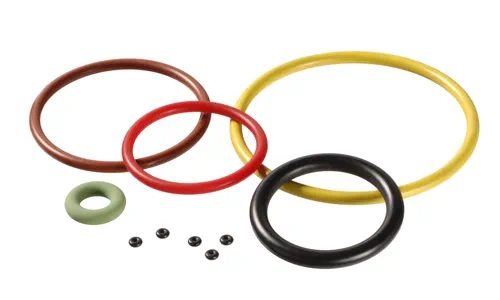Rubber refers to a polymer compound with high elasticity. Seals made of rubber are suitable for most fluids. By selecting different rubber materials, it can meet the requirements of different media, climate, temperature, and insulation.Rubber is natural rubber and can also be artificially synthesized, so the price of rubber is relatively low. It is still the most widely used sealing material in different industries. Representative products include O-rings, star-rings, D-rings, gaskets, vibration isolators, oil seals, etc. Among them, O-rings are particularly widely used. Because O-ring has the following advantages:
1) It can be used for various seals, such as static seal, dynamic seal, single-acting seal, double-acting seal
2) Wide selection of materials, suitable for various fluids
3) It can be reused in many occasions
4) The groove is simple, which reduces the design and processing costs
5) Easy to repair, not easy to damage and re-tighten,
6) Suitable for a wide range of pressure, gap and temperature occasions
| Material | Rubber name | temperature range | Material performance | shortcoming |
FFKM (AED) (FDA) | FFKM | -25~330℃ | It is chemically inert and stable to all media, including fats, aromatic hydrocarbons, esters, mysteries, ketones, oils, lubricants and most acids. Excellent high temperature resistance. Special grades can be applied for a long time at 300℃ or intermittently at 325℃. Our company's perfluorinated mystery material grades can be interchanged with DuPont Kalrez working conditions. | Affected by some strong oxidants and reducing agents, swelling occurs in HCFC, CFC, fluorine oil, chlorotrifluoroethylene oil and other media. expensive |
FKM (AED) (FDA) | Binary copolymer FKM | -45~250℃ | The best compression set and excellent fluid resistance of fluorine rubber, equivalent to DuPont brand VITON A | Not suitable for use in polar solvents such as (ketones), some organic acids such as formic acid, certain methanol and ester hydraulic fluids, ammonia and amines |
| Ternary copolymer FKM | Compared with binary copolymerization, it has better fluid resistance, oil resistance and solvent resistance. Equivalent to DuPont brand VITON B | |||
| Quaternary copolymer FKM | The quaternary copolymer is divided into three types: GF/GLT/GFLT GF has excellent high temperature and chemical resistance, but its physical properties and low temperature properties are reduced GLT improves low temperature resistance but reduces chemical resistance GFLT has excellent high temperature and low temperature cycle performance and chemical resistance | |||
AFLAS (AED) | Four propylene fluorine rubber | -25~250℃ | AFLAS has the electrical properties of silica gel and EPDM, which are not available in ordinary FKM. It can resist high concentrations of acids, alkalis, amines, oxidants, hot water, water vapor, etc. under high temperature conditions. It can work continuously at 260°C for 30 days, or it can be used at 300°C for a period of time. Especially for the high concentration of hydrogen sulfide (5%~30%) in natural gas mining, AFLAS is one of the rubber solutions second only to perfluorinated rubber | The resilience of AFLAS is worse than that of FKM, especially under low temperature conditions |
HNBR (AED) | HNBR | -40~180℃ | HNBR has high strength and high tearing performance, and has become a low-cost alternative to FKM. In addition to good low-temperature resistance, HNBR with ultra-low acrylonitrile content can also resist the mixed gas of hydrogen sulfide (up to 5%), methane, and carbon dioxide. (Oil drilling industry) degradation | The heat resistance of HNBR is slightly worse than that of FKM |
EPDM | EPDM | -40~180℃ | It has excellent heat resistance, oxygen resistance, ozone resistance, and weather resistance. It can also withstand a wide range of media, such as polar solvents (ketones, lipids), hot water and steam at 200°C (without air) | Not suitable for mineral, synthetic lubrication and hydrocarbon fuels |
FVMQ | FVMQ | -70~200℃ | It has good low temperature resistance, and has good stability to aliphatic hydrocarbons, aromatic hydrocarbons, chlorinated hydrocarbons, petroleum-based fuel oils, lubricating oils, hydraulic oils and some synthetic oils at room temperature and high temperature. | Low temperature and high temperature resistance performance is not as good as silica gel, 300 ℃ will produce toxic gas |
| PU | PU | -30~100℃ | It is resistant to lubricating oil and fuel oil, has good swelling resistance, tear resistance and outstanding tensile strength. It is the most wear-resistant rubber | Poor hydrolytic stability and heat resistance |
| NBR | NBR | -40~120℃ | Resistant to non-polar solvent oils, cheap, and one of the most widely used special rubbers | Ozone resistance, poor electrical insulation, swelling or even dissolving in polar chlorinated solvents and esters |
VMQ (FDA) | VMQ | -90~300℃ | The only rubber that is resistant to severe cold and high temperature. Resistant to bacteria, fungi, ozone, outdoor weather, and burning. Good electrical insulation and air permeability, good compression deformation. | Not resistant to acid, alkali, or abrasion, low tensile properties |
If you need to know the material characteristics in detail, you can contact our business people to send detailed information
Mobile:+86-13715124957
Email: [email protected]
Whatsapp: +86-13715124957